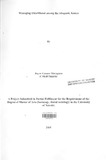| dc.description.abstract | The world population aged 60 years and above is rapidly increasing despite poverty and
the prevalence of the AIDS pandemic. This increase is being experienced largely in
developing countries. The older people are consistently and disproportionately among
the poorest and most marginalized in society. This therefore calls for the need to set
higher priority on the realization of older peoples human rights and freedoms such as the
right to life, security of the individual and property.
The older people need adequate support so as so enjoy good health and lead very active
and fulfilling lives. This calls for research on the challenges/experiences facing the
elderly population and their management. There is also need to try to understand their
nature and dimensions and sources. This study therefore endeavors to generate information on the experiences faced by the
elderly people in terms of their management hence survival in Keumbu Division Kisii
district. The specific objectives of the study were to understand the problems
experienced by elderly people in their day to day living, to assess the role of relatives,
community and government in managing elderly people. and to assess the response on
aging by policy makers.
The study was guided by the following hypotheses: - Poor knowledge about their
old-age management affects elder lies' access to basic needs,
Negative/perception of the family and community towards the elderly people
positively affect their management and Limited involvement by policy makers
affects elderly peoples' management strategies. A total of sixty older people were selected for the study. This sample included both male
and female ages between 60 and 91years. Drawn from the five sub-locations among
nine sub-locations in two locations of the study area. The household formed the basic
unit of analysis while those aged between 60-91 years formed the units of enquiry or
observations. Purposive sampling was used to identify the first who elderly people and
there after the Snowball method was used to get other respondents. This was because
there was no official register for all the elderly people in the area under study. Both
primary and secondary data were. utilized. Primary data was collected usmg
questionnaires and interview schedules. Key officials (chiefs, assistant chiefs, optruon
leaders and community development workers) also provided information, which was
collected from the respondents. Personal observation method was also utilized for data
collection. Both published and unpublished documentary materials were used to obtain
secondary data. The collected data was presented in form of tables, frequencies and
percentages coupled with narrations for descriptive data. | en |

